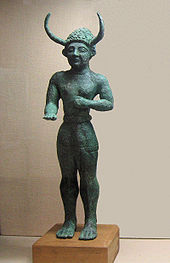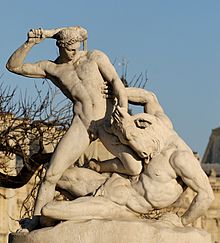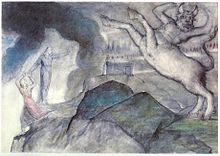- Minotaur
-
Minotaur 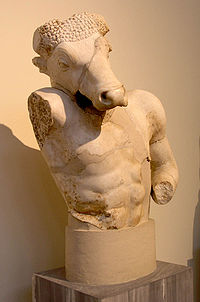
Minotaur bust, (National Archaeological Museum of Athens)Mythology Greek Grouping Legendary creature Parents Cretan Bull and Pasiphaë Region Crete Topics in Greek mythology - Gods
- Primordial gods and Titans
- Zeus and the Olympians
- Pan and the nymphs
- Apollo and Dionysus
- Sea-gods and Earth-gods
- Heroes
- Related
 Greek mythology portal
Greek mythology portalIn Greek mythology, the Minotaur (Ancient Greek Μῑνώταυρος [miːnɔ̌ːtau̯ros], Latin: Minotaurus, Etruscan Θevrumineś), as the Greeks imagined him, was a creature with the head of a bull on the body of a man[1] or, as described by Roman poet Ovid, "part man and part bull".[2] He dwelt at the center of the Cretan Labyrinth, which was an elaborate maze-like construction[3] designed by the architect Daedalus and his son Icarus, on the command of King Minos of Crete The Minotaur was eventually killed by the Athenian hero Theseus.
The term Minotaur derives from the Ancient Greek Μῑνώταυρος, a compound of the name Μίνως (Minos) and the noun ταύρος "bull", translating as "(the) Bull of Minos". In Crete, the Minotaur was known by its proper name, Asterion,[4] a name shared with Minos' foster-father.[5]
Minotaur was originally a proper noun in reference to this mythical figure. The use of minotaur as a common noun to refer to members of a generic race of bull-headed creatures developed much later, in 20th-century fantasy genre fiction.
Contents
Birth and appearance
After he ascended the throne of Crete, Minos competed with his brothers to rule. Minos prayed to Poseidon to send him a snow-white bull, as a sign of support. He was to kill the bull to show honor to Poseidon but decided to keep it instead because of its beauty. He thought Poseidon would not care if he kept the white bull and sacrificed one of his own. To punish Minos, Aphrodite made Pasiphaë, Minos' wife, fall deeply in love with the bull from the sea, the Cretan Bull.[6] Pasiphaë had the archetypal craftsman Daedalus make a hollow wooden cow, and climbed inside it in order to copulate with the white bull. The offspring of their coupling was the monstrous Minotaur. Pasiphaë nursed him in his infancy, but he grew and became ferocious; being the unnatural offspring of man and beast, he had no natural source of nourishment and thus devoured man for sustenance. Minos, after getting advice from the oracle at Delphi, had Daedalus construct a gigantic labyrinth to hold the Minotaur. Its location was near Minos' palace in Knossos.
Nowhere has the essence of the myth been expressed more succinctly than in the Heroides attributed to Ovid, where Pasiphaë's daughter complains of the curse of her unrequited love: "the bull's form disguised the god, Pasiphaë, my mother, a victim of the deluded bull, brought forth in travail her reproach and burden."[7] Literalist and prurient readings that emphasize the machinery of actual copulation may, perhaps intentionally, obscure the mystic marriage of the god in bull form, a Minoan mythos alien to the Greeks.[8]
The Minotaur is commonly represented in Classical art with the body of a man and the head and tail of a bull. One of the figurations assumed by the river god Achelous in wooing Deianira is as a man with the head of a bull, according to Sophocles' Trachiniai.
From Classical times through the Renaissance, the Minotaur appears at the center of many depictions of the Labyrinth.[9] Ovid's Latin account of the Minotaur, which did not elaborate on which half was bull and which half man, was the most widely available during the Middle Ages, and several later versions show the reverse of the Classical configuration, a man's head and torso on a bull's body, reminiscent of a centaur.[10] This alternative tradition survived into the Renaissance, and still figures in some modern depictions, such as Steele Savage's illustrations for Edith Hamilton's Mythology (1942).
Theseus and the Minotaur
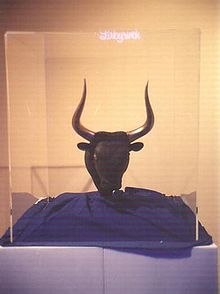 Rhyton in the shape of a bull's head, Heraklion Archaeological Museum; shown here at the Greek pavilion at Expo '88
Rhyton in the shape of a bull's head, Heraklion Archaeological Museum; shown here at the Greek pavilion at Expo '88
Androgeus, son of Minos, had been killed by the Athenians, who were jealous of the victories he had won at the Panathenaic festival. Others say he was killed at Marathon by the Cretan bull, his mother's former taurine lover, which Aegeus, king of Athens, had commanded him to slay. The common tradition is that Minos waged war to avenge the death of his son and won. Catullus, in his account of the Minotaur's birth,[11] refers to another version in which Athens was "compelled by the cruel plague to pay penalties for the killing of Androgeos." Aegeus must avert the plague caused by his crime by sending "young men at the same time as the best of unwed girls as a feast" to the Minotaur. Minos required that seven Athenian youths and seven maidens, drawn by lots, be sent every ninth year (some accounts say every year[12]) to be devoured by the Minotaur.
When the third sacrifice approached, Theseus volunteered to slay the monster. He promised to his father, Aegeus, that he would put up a white sail on his journey back home if he was successful and would have the crew put up black sails if he was killed. In Crete, both Minos' daughters, Ariadne and Phaedra fell madly in love with Theseus. Ariadne, the elder, helped him navigate the labyrinth. In most accounts she gave him a ball of thread, allowing him to retrace his path. Theseus killed the Minotaur with the sword of Aegeus and led the other Athenians back out of the labyrinth. On the way home, Theseus abandoned Ariadne on the island of Naxos, and continued with Phaedra, his future wife. He neglected, however, to put up the white sail. King Aegeus, from his lookout on Cape Sounion, saw the black-sailed ship approach and, presuming his son dead, threw himself into the sea that is since named after him, thus committing suicide.[13] This act secured the throne for Theseus.
Etruscan view
 Pasiphaë and the Minotaur, Attic red-figure kylix found at Etruscan Vulci (Cabinet des Médailles, Paris)
Pasiphaë and the Minotaur, Attic red-figure kylix found at Etruscan Vulci (Cabinet des Médailles, Paris)
This essentially Athenian view of the Minotaur as the antagonist of Theseus reflects the literary sources, which are biased in favour of Athenian perspectives. The Etruscans, who paired Ariadne with Dionysus, never with Theseus, offered an alternative Etruscan view of the Minotaur, never seen in Greek arts: on an Etruscan red-figure wine-cup of the early-to-mid fourth century Pasiphaë tenderly dandles an infant Minotaur on her knee.[14]
Interpretations
The contest between Theseus and the Minotaur was frequently represented in Greek art. A Knossian didrachm exhibits on one side the labyrinth, on the other the Minotaur surrounded by a semicircle of small balls, probably intended for stars; one of the monster's names was Asterion ("star").
The ruins of Minos' palace at Knossos have been found, but the labyrinth has not. The enormous number of rooms, staircases and corridors in the palace has led some archaeologists to suggest that the palace itself was the source of the labyrinth myth, an idea generally discredited today.[15] Homer, describing the shield of Achilles, remarked that the labyrinth was Ariadne's ceremonial dancing ground.
Some modern mythologists regard the Minotaur as a solar personification and a Minoan adaptation of the Baal-Moloch of the Phoenicians. The slaying of the Minotaur by Theseus in that case indicates the breaking of Athenian tributary relations with Minoan Crete.
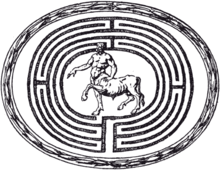 The Minotaur in the Labyrinth, engraving of a 16th-century gem in the Medici Collection in the Palazzo Strozzi, Florence [16]
The Minotaur in the Labyrinth, engraving of a 16th-century gem in the Medici Collection in the Palazzo Strozzi, Florence [16]
According to A. B. Cook, Minos and Minotaur are only different forms of the same personage, representing the sun-god of the Cretans, who depicted the sun as a bull. He and J. G. Frazer both explain Pasiphaë's union with the bull as a sacred ceremony, at which the queen of Knossos was wedded to a bull-formed god, just as the wife of the Tyrant in Athens was wedded to Dionysus. E. Pottier, who does not dispute the historical personality of Minos, in view of the story of Phalaris, considers it probable that in Crete (where a bull-cult may have existed by the side of that of the labrys) victims were tortured by being shut up in the belly of a red-hot brazen bull. The story of Talos, the Cretan man of brass, who heated himself red-hot and clasped strangers in his embrace as soon as they landed on the island, is probably of similar origin.
A historical explanation of the myth refers to the time when Crete was the main political and cultural potency in the Aegean Sea. As the fledgling Athens (and probably other continental Greek cities) was under tribute to Crete, it can be assumed that such tribute included young men and women for sacrifice. This ceremony was performed by a priest disguised with a bull head or mask, thus explaining the imagery of the Minotaur. It may also be that this priest was son to Minos.
Once continental Greece was free from Crete's dominance, the myth of the Minotaur worked to distance the forming religious consciousness of the Hellene poleis from Minoan beliefs.
The Minotaur in Dante's Inferno
The Minotaur, the infamia di Creti, appears briefly in Dante's Inferno, Canto 12,11-15, where, picking their way among boulders dislodged on the slope and preparing to enter into the Seventh Circle,[17] Dante and Virgil, his guide, encounter the beast first among those damned for their violent natures, the "men of blood", though the creature is not actually named until line 25.[18] At Virgil's taunting reminder of the "Duke of Athens", the Minotaur rises enraged and distracted, and Virgil and Dante pass quickly by to the centaurs, who guard the Flegetonte, "river of blood". This unusual association of the Minotaur with centaurs, not made in any Classical source, is shown visually in William Blake's rendering of the Minotaur (illustration) as a kind of taurine centaur himself.
See also
- Apis, the Egyptian god is often depicted as a bull, or bull-headed man.
- Bull-Leaping Fresco
- Mesopotamian mythology: Shedu had a bull body and a human head.
- Minoan Bull-leaper
- Molech or Ba'al worshipped in the Middle East, and depicted as a man with the head of a bull.
- Sarangay, a creature resembling a bull with a huge muscular body and a jewel attached to its ears
- Ushi-oni Another bull-headed monster; from Japanese folklore.
- Mini, a character from the comic book NEW-GEN who traveled back in time and inspired the legend of the monster itself.
References
- Minotaur in Greek Myth source Greek texts and art.
Notes
- ^ "Minotaur" at dictionary.reference.com
- ^ semibovemque virum semivirumque bovem, according to Ovid, Ars Amatoria 2.24, one of the three lines that his friends would have deleted from his work, and one of the three that he, selecting independently, would preserve at all cost, in the apocryphal anecdote told by Albinovanus Pedo. (noted by J. S. Rusten, "Ovid, Empedocles and the Minotaur" The American Journal of Philology 103.3 (Autumn 1982, pp. 332-333) p. 332.
- ^ Labyrinth patterns as painted or inscribed do not have dead ends like a maze; instead, a single path winds to the center, where, with a single turn, the alternate path leads out again. See Kern, Through the Labyrinth, Prestel, 2000, Chapter 1, and Doob, The Idea of the Labyrinth, Cornell University Press, 1990, Chapter 2.
- ^ Pausanias, Description of Greece 2. 31. 1
- ^ The Hesiodic Catalogue of Women, says of Zeus' establishment of Europa in Crete: "...he made her live with Asterion the king of the Cretans. There she conceived and bore three sons, Minos, Sarpedon and Rhadamanthys."
- ^ In Greek mythology, the Cretan Bull was equally the bull that carried away Europa.
- ^ Walter Burkert notes the fragment of Euripides' The Cretans (C. Austin's frs. 78-82) as the "authoritative version" for the Hellenes.
- ^ See R.F. Willetts, Cretan Cults and Festivals (London, 1962); Pasiphaë's union with the bull has been recognized as a mystical union for over a century: F. B. Jevons ("Report on Greek Mythology" Folklore 2.2 [June 1891:220-241] p. 226) notes of Europa and Pasiphaë, "The kernel of both myths is the union of the moon-spirit (in human shape) with a bull; both myths, then, have to do with a sacred marriage."
- ^ Several examples are shown in Kern, Through the Labyrinth, Prestel, 2000.
- ^ Examples include illustrations 204, 237, 238, and 371 in Kern. op. cit.
- ^ Carmen 64.
- ^ The annual period is given by J. E. Zimmerman, Dictionary of Classical Mythology, Harper & Row, 1964, article "Androgeus"; and H. J. Rose, A Handbook of Greek Mythology, Dutton, 1959, p. 265. Zimmerman cites Virgil, Apollodorus, and Pausanias. The nine-year period appears in Plutarch and Ovid.
- ^ Plutarch, Theseus, 15—19; Diodorus Siculus i. I6, iv. 61; Bibliotheke iii. 1,15
- ^ The wine cup is illustrated in Larissa Bonfante and Judith Swaddling, Etruscan Mythology (Series The Legendary Past, British Museum / University of Texas) 2006, fig.29 p. 44 ("early fourth century") (on-line illustration).
- ^ Sir Arthur Evans, the first of many archaeologists who have worked at Knossos, is often given credit for this idea, but he did not himself believe it; see David McCullough, The Unending Mystery, Pantheon, 2004, p. 34-36. Modern scholarship generally discounts the idea; see Kern, Through the Labyrinth, Prestel, 2000, p. 42-43, and Doob, The Idea of the Labyrinth, Cornell University Press, p. 1990, p. 25.
- ^ Paolo Alessandro Maffei, Gemmae Antiche, 1709, Pt. IV, pl. 31; Hermann Kern, Through the Labyrinth, Prestel, 2000, fig. 371, p. 202): Maffei "erroneously deemed the piece to be from Classical antiquity".
- ^ The traverse of this circle is a long one, filling Cantos 12 to 17.
- ^ Jeremy Tambling, "Monstrous Tyranny, Men of Blood: Dante and "Inferno" XII" The Modern Language Review 98.4 (October 2003:881-897).
Categories:- Cretan mythology
- Greek legendary creatures
- History of Crete
- Labours of Theseus
- Mythological bovines
- Mythological hybrids
- Mythic humanoids
Wikimedia Foundation. 2010.

